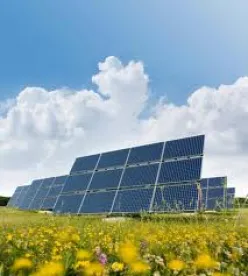One of the technologies showcased at ARPA-E again this year was from Glint Technology. I first spoke with this company last year, and now understand that they think their technology will be "ready for prime time" in one more year. The concept is elegantly simple: a solar concentrator that can capture the full amount of sunlight regardless of the sun's position and without moving the solar panels. Glint's inexpensive solution is to use an "automatic" optical system of fluid layers that adjust their positions in response to solar heat. In the demonstration device shown at the ARPA-E showcase it looked like the kind of diffuser panel that are used for overhead fluorescent tube fixtures, only this "diffuser" is laid out on top of a solar panel.
Borrowing from the company's website explanation: the self-tracking solar concentrator has an embedded liquid layer which provides passive and automatic optical alignment to the incident sunlight, adjusting the optical properties of the concentrator to track the position of the sun. This “self-tracking” functionality is actuated by the sunlight itself, and does not require any control system. It results in high-concentration optics with a wide effective acceptance angle, eliminating the requirement for costly precise alignment systems and instead delivers high efficiency conversion at low system cost.
The self-aligning concentrator photovoltaic module maintains the simple mounting characteristics of traditional flat-plate PV, and may be placed on standard low-precision trackers or even in stationary configurations. The design permits wide manufacturing tolerances, as the concentrator can automatically compensate for misalignment and manufacturing variability in the optical components. The concentrator itself is designed to be extremely low-cost, due to low material usage and simple manufacturing.
One more way the cost of solar energy is going to be reduced in the future?




 />i
/>i
